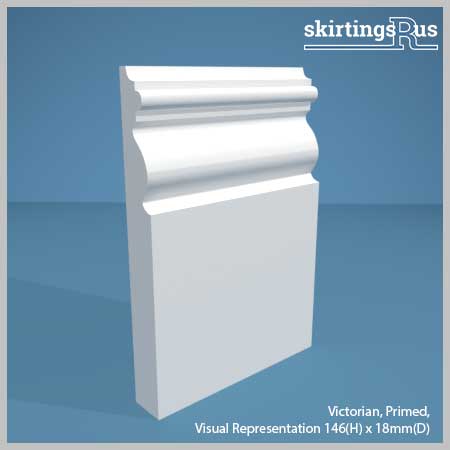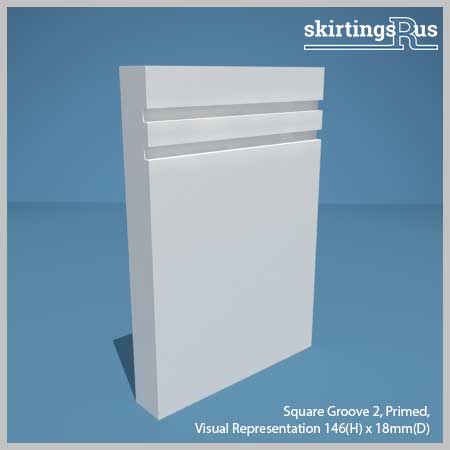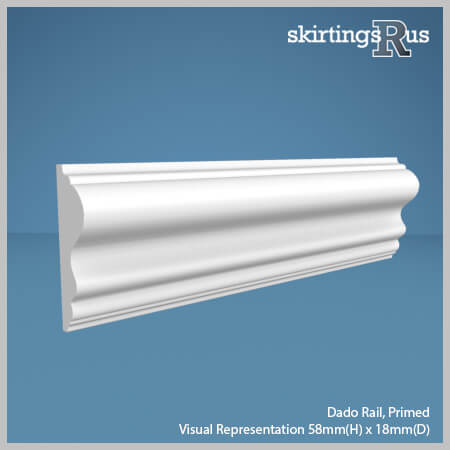How To Choose the Right Skirting Board Size
What is the best way to choose your skirting board size?
This is a question we are regularly asked which does not have a ‘one size fits all’ answer. Skirting board can come in almost any size, but whilst there are a variety of dimensions; to make it simpler, the choice often comes down to whether you want a regular or large moulding, based on how those mouldings will work with your space.
You can find more information on moulding dimensions in the second part of this guide 'Skirting board dimensions guide: Choosing the right size for your space'.
Aesthetic choices
Depending on your own aesthetics, each unique property may lend itself more comfortably to a different size and moulding. This also has to be balanced against what you want to achieve with your interior.
The starting point to deciding which skirting board height will suit your interior design ambitions is to ask yourself a few questions:
- What period does my property belong to ?
- How high are the ceilings ?
- What aesthetic am I trying to achieve in terms of colour and style ?


Image Credit: House and Garden
Recreate this Georgian interior look with Palace skirting board
Property age or period
The age and style of your property is probably the most influential factor in deciding skirting height.
Period Properties
Making the decision as to what to buy is easier if you are the owner of a period property.
Period properties (Victorian, Georgian, and Regency to name a few) all tended to be built with high ceilings, creating impressive, grand room spaces.
High skirting boards are an iconic feature in these historic properties as they usually feature large elaborate mouldings, which draw the eye.
More importantly, taller skirting boards serve to keep the scale of larger rooms proportionately balanced. As I'm sure you will agree, a huge room would look strange with comparatively smaller furniture filling it – the same goes for your skirting boards.
For these reasons, taller skirting with a large moulding is undoubtedly the way to go if you own a period property. The 8”/200mm mark and above is normally considered a large skirting board size. Installing a larger board will bring continuity to the building design, by maintaining proportions with room sizes, and make for an intriguing feature around the room perimeters. Look at how these principles get bought together with the beautiful Georgian interior shown.
Tip: If you opt for a larger board, make sure that the shape that is machined onto the board is also large (proportionate to the board size), otherwise you could buy skirting that has a small 50mm shape with a large flat section underneath it.
Moulded shapes are usually 50mm high, but larger shapes can be up to 100mm high. The larger size moulding will be better proportioned for boards that are specified taller.
We offer a complete range of large skirting boards featuring a larger detailed profile, proportionate to larger skirting sizes.
Ready to make your period skirting boards selection?
Modern Properties
Since these earlier building periods, modern properties have typically been built with far lower ceilings and been far less elaborate in design. They therefore tend to use shorter skirting boards, usually up to the 6”/150mm mark, which are more proportionate with the rooms and ceiling heights.
Although this tends to be the norm, it is by no means correct to assume that this is always the case. Like in the the modern interior image shown, we have found that modern buildings/interiors can look especially stunning with a larger skirting board, as it helps bring a greater depth of features to the interior design. A grooved design - like Bullnose Groove 3 skirting board with matching Bullnose Groove 3 architrave - can also help keep thing contemporary if your pursuing an ultra modern look.
Ceiling Height
It should be pointed out that when your ceiling isn’t that high, tall skirting boards can make the ceiling feel lower than it really is – as they eat up the height of the exposed wall.
This can be an issue if you have particularly low ceilings below the usual 2.4m, however if you can use a large skirting board they definitely deliver a strong feeling of quality throughout an interior.


Image Credit: Houzz
Recreate this modern interior look with Regency skirting board 221mm (H)
Interior Style
While property age can favour higher skirting board sizes, larger or smaller skirting boards can emphasise or detract from interior design principles.
Simply put, taller boards create a bigger impact, while a smaller skirting can deliver a subtler effect. However there are a few other variables to consider prior to making your choice.
To enhance your skirting board size decision, here are a couple more interior design principles to think about.
Colour Schemes
Using contrasting colours
Skirting boards painted in contrast to your wall colour can produce a powerful aesthetic – especially when a strong wall colour is used.
Using a larger skirting can help to deliver a bigger, more obvious contrasting impact, whereas using a smaller board can help restrict the effect. The balance that you are looking to strike will influence how tall you want your skirting board to be, and how prominently you want them to feature.
Compare the two images below to get an insight.


Image Credit: Dulux
Recreate this small contrasting skirting board look with Bullnose skirting board


Image Credit: Overmantels
Recreate this large contrasting skirting board look with Roux skirting board 221mm (H)
Using continuous colours
On the other hand using colour continuously across walls and skirting may impact on you size decision.
If the skirting is supposed to be blending into the wall colour, it may mean that you only want to use a smaller skirting, since it will be a less obvious feature in the room anyway.
However, painting the same colour as walls does not render the skirting board invisible.
You may still want to make a prominent feature of the shape on the board – especially if they are going into a period property.
In this case you may consider opting for a high skirting board so as to increase their presence within a room (like in the next image shown).
In cases like this, you might want to look for a moulding with a prominent shadow profile to add some texture along the foot of the wall.
If you'd like to learn more about colour use on skirting boards and architraves, there's more information on our guide: How to use colour on skirting boards.


Image Credit: The Paint & Paper Library
Recreate this continuous colour look with Period skirting board


Image Credit: Hughes Developments
Recreate this minimalist look with Large Kensington skirting board
Minimalist Styles
When it comes to the style that you are trying to achieve, skirting board can be made to fit into any scheme, but the shape and colour will also influence how they tie into a scheme.
In a minimalist scheme skirting can be used to add layers of detail to a room that may otherwise feel empty, without adding too great of a feature as for instance a piece of furniture might. This presence can then be increased by increasing their size or complexity of shape, according to taste.
You can see an example of how large skirting boards have been used in this way in this Hughes Developments image.
Maximalist Styles
Maximalist interiors usually feature very prominent pieces of furniture or decoration and are often the centrepiece of a room.
Maximalist design features do not want the eye drawn from them. Smaller skirting boards may be more suitable for these types of interiors, to stop attention being drawn from intended feature pieces and ‘blend’ the skirting board into the background of the room.
The selected skirting could also feature a plain design, be painted the same colour as the wall, and/or be smaller in size. Each of these factors will likely make it less conspicuous in a room.
Check out how the interior shown in the next image, blends its rather large skirting board into the wall, so as not to detract from more detailed room features.


Image Credit: Shoot Factory
Recreate this maximalist look with Cheshire skirting board
Ready to make your skirting boards style selection?
Summary
So, to sum things up:
- Period properties are normally suited to larger skirting boards, while modern homes are usually suited to smaller sizes.
- Larger skirting boards can deliver a stronger statement in a room, emphasise colours and add detail, whereas shorter boards can deliver a subtler effect to prevent attention being drawn away from centre pieces.
These ideas should help guide your choice when choosing a skirting board size and style, but how you choose to balance these principles is down to your own personal opinion and how you are going to be decorating the room going forward.
For further hints and tips, we also provide regular news and hints to our email subscribers (with the occasional exclusive offer!) which you can sign up to below.




















.png)
















